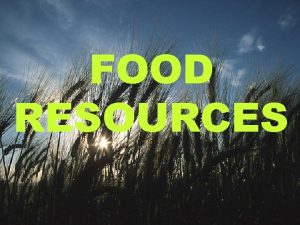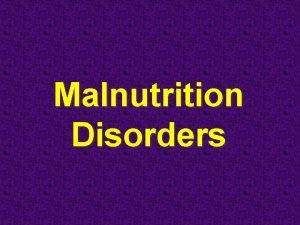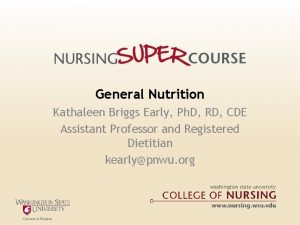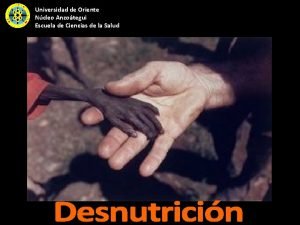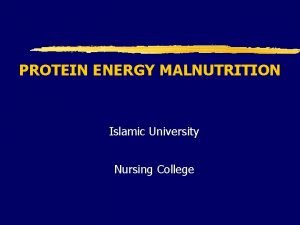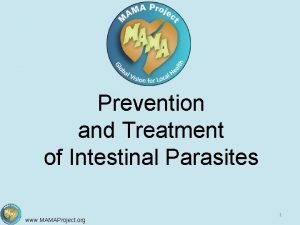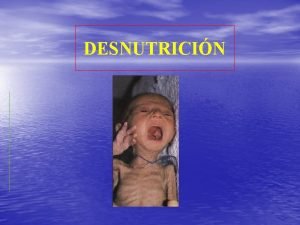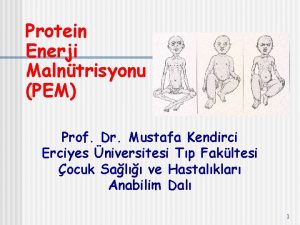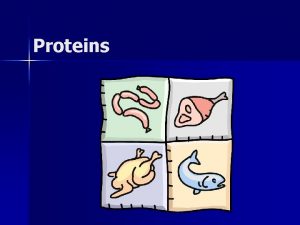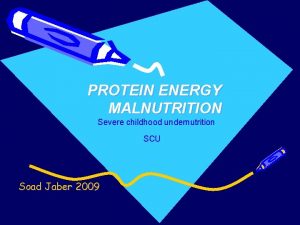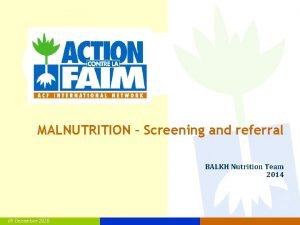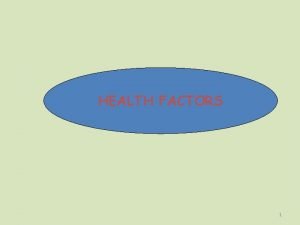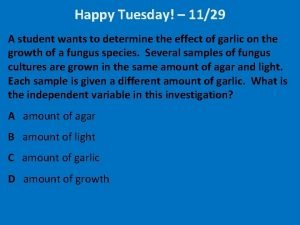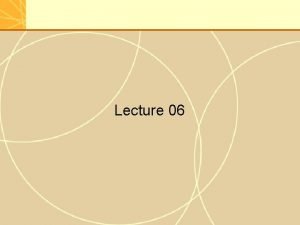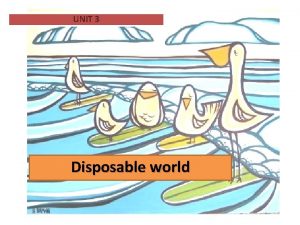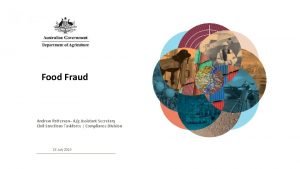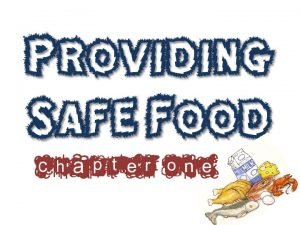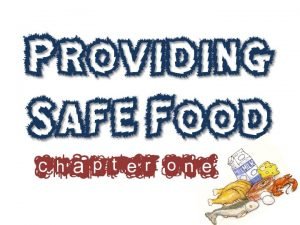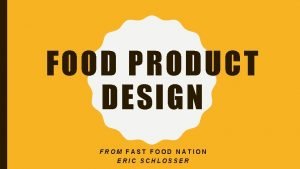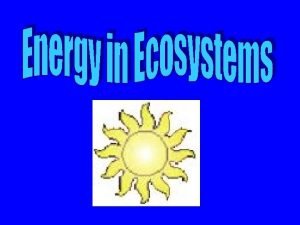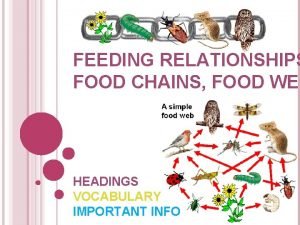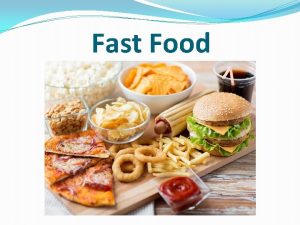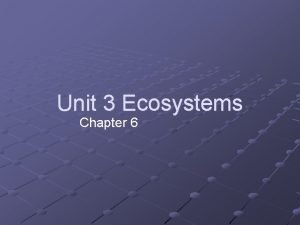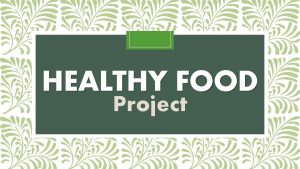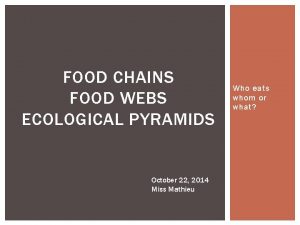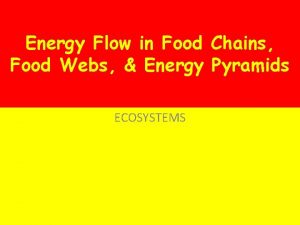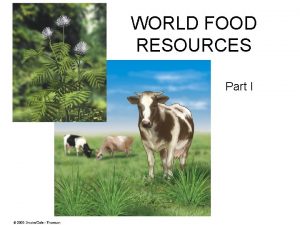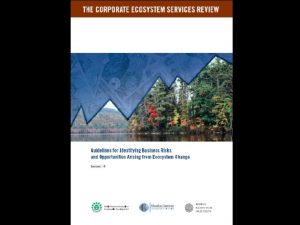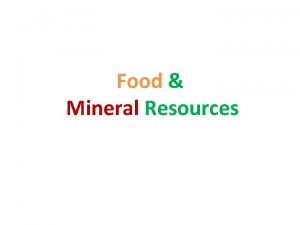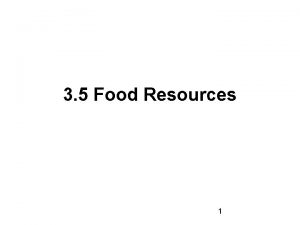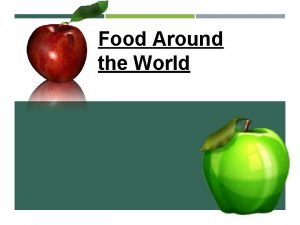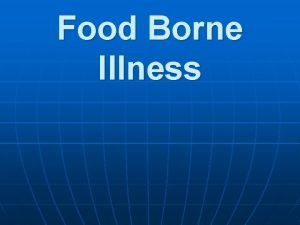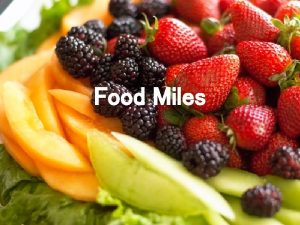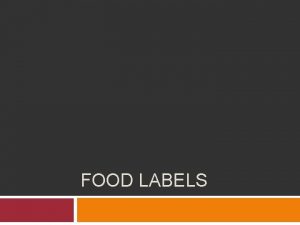WORLD FOOD RESOURCES Part I Kwashiorkor Kwashiorkor is





























































- Slides: 61

WORLD FOOD RESOURCES Part I

Kwashiorkor • Kwashiorkor – is a type of malnutrition that occurs in infants and very young children when they are weaned from mother’s milk to a starchy diet low in protein.

Recent Studies • Indicate that over 50% of all children will be overweight or suffer from over-nutrition by the year 2010!

USA • 2. 1 million children under the age of 5 live in poverty in the USA. • Poverty - The state of being poor; lack of the means of providing material needs or comforts. • WIC (Supplemental Nutrition Program for Woman, Infants, and Children) – provide assistance to support proper nutrition for general wellness and to help children focus and do well in school. Children who are hungry do not function at the same level in school as children who are well-fed.

NUTRITION

Unmet Nutritional Needs • Undernutrition – people who cannot grow or buy enough food to meet their basic energy needs. • Malnutrition – people who are forced to live on low-protein, high carbohydrate diet consisting of grains such as wheat, rice, and corn often suffer from malnutrition. • 17% of the people in developing countries suffer from undernutrition and/or malnutrition.


Food Resources • Approximately 15 plant and 8 animal species. • Three main cash crops: 1. wheat 2. rice 3. corn Grown by Industrialized agricultural methods (developed nations) and Traditional methods including subsistence and intensive (developing nations)

Wheat and corn (industrial agriculture) Rice (Intensive agriculture)

Livestock • • • Cattle – beef = affluence Horses Oxen Sheep Chicken hogs

Cattle Ranching Beef Cows Dairy Cows

Types of Agriculture • • • Industrialized Agriculture – “Agribusiness” Developed countries Land – moderate amount Labor – low Capital Costs – high (use a lot of fertilizer, pesticides, and irrigation systems) • Energy Use (fossil fuels) – high • Environmental Impacts - high

Industrialized Agriculture

Types of Agriculture • Intensive Traditional (Rice fields, China, Thailand) • Developing countries • Capital Costs – low (use fertilizer and will divert water for irrigation through dams on occasion) • Energy use (fossil fuels) – low • Environmental Impacts (low-moderate)

Intensive Agriculture Rice Paddies

Types of Agriculture • Shifting Cultivation • Developing countries • Land – large tracts of tropical forests cleared and used for agriculture • Labor – low-moderate • Capital Costs – low (rarely use fertilizer) • Energy use – low to none • Shift agricultural plots of land until nutrients are restored to land. • Environmental Impacts (moderate)

Types of Agriculture • • Nomadic Herding Developing countries Land – large tracts Labor – low Capital Costs – low Energy use (fossil fuels) – none Yak in Tibet (Snow Leopard Video)

Industrialized agriculture Plantation agriculture Intensive traditional agriculture Shifting cultivation Nomadic herding No agriculture

Pre-Green revolution • • • 1912 – German chemist Fritz Haber developed a process for synthesizing ammonia directly from nitrogen and hydrogen. “The Haber Process” At the start of World War I, in 1914, Germany was dependent on nitrate deposits in Chile for nitrogen containing compounds needed to manufacture explosives. The Allied naval blockade of South America cut off this supply. By fixing nitrogen from the air, Germany was able to continue explosives production. From this incident and the development of the Haber process, scientists have continued to fix nitrogen to manufacture fertilizers that have increased crop yields. Approximately 50 billion pounds of ammonia are manufactured annually in the USA = BIG BUSINESS! The decision to award Fritz Haber the Nobel Prize for Chemistry in 1918 was the subject of considerable controversy since he served as chief of Germany’s Chemical Warfare Service and developed chlorine as a poison gas-weapon later used in Nazi Germany concentration camps. He was awarded the Nobel Prize because it was believed that “the world would never go hungry again”. The ultimate irony came in 1933 when Haber was expelled from Germany because he was Jewish!

Haber Process

Green Revolution (1950 -1970) • Plant monocultures to obtain high yields. • Input pesticides and fertilizers to obtain high yields. • Increase frequency and intensity of cropping to obtain high yields. • Was all of this done to “feed the world” or make high profits?

Trade-Offs Inorganic Commercial Fertilizers Advantages Disadvantages Easy to transport Do not add humus to soil Easy to store Reduce organic matter in soil Easy to apply Reduce ability of soil to hold water Inexpensive to produce Lower oxygen content of soil Help feed one of every three people in the world Without commercial inorganic fertilizers, world food output could drop by 40% Require large amounts of energy to produce, transport, and apply Release the greenhouse gas nitrous oxide (N 2 O) Runoff can overfertilize nearby lakes and kill fish

2 nd Green Revolution • Introduction of genetically modified crops to obtain high yields. • New herbicides introduced.

New Green Revolution • “Sasakawa Global 2000” • Ryoichi Sasakawa, Norman Bourlag & Jimmy Carter • Goal: Obtain high yields in an environmentally friendly way by introducing • Integrated Management Plans (IPM’s) • Terracing • Intercropping.

Terracing – Coffee Plantation Form of Contour Plowing

Economics of Agriculture • • • AGRICULTURE MAKES UP 20% OF USA’S GNP! = BIG BUSINESS High input = high output (high yields) Industrial Agriculture uses: 1. tremendous amounts of energy (fossil fuels) 2. Moderate amount of land 3. fertilizers and pesticides Food costs/salary have decreased by 50% since 1940 due to “relatively” cheap energy (subsidies), mass growing and processing. ALL leading to environmental degradation. Environmental degradation costs billions of dollars to attempt to repair structure and function losses of ecosystems. Restoration of habitats usually will NOT replace the originally lost structure, function and values of ecosystems.

Economics of the Hamburger • 1 acre of forest supports 800, 000 pounds of plants and animals. • 1 acre = 43, 560 square feet • 1 bovine = 200 pounds of actual beef • 200 pounds of beef = (800) 4 ounce hamburgers • 1 hamburger = ½ ton (1000 pounds) of forest products • 1 hamburger = 55 square feet of forest • Two 4 oz. Hamburgers will fill 45 -50 bowls with cooked cereal grains for undernutrition/malnutritioned children in the USA. • 2. 1 million children under the age of 3 live in poverty in the USA!

Environmental Degradation

Environmental Degradation

Runoff From Slaughter Houses


The formation of Soil • It takes hundreds to thousands of years for soil to form. • Soil is the result of physical and chemical weathering of rocks and the gradual accumulation of detritus (organic. . . ) from the biosphere. • 2 main parts • 1) Breakdown of primary materialrocks/minerals • II) Deposition of organic material.

Five Factors Determine Properties of Soils • 1) Parent Material • 2) Climate-soils do not form well when temperatures are below freezing • 3) Topography-surface slope/landscape arrangement. • 4) Organisms • 5) Time

Physical Properties of Soil • Sand, Silt and Clay are the mineral particles of different sizes. • The Texture of a soil is determined by the percentages of sand, silt and clay it contains. • Porosity of a soil--how quickly soil drains depends on its texture.



Compaction and Salinization of Soils

Effects of Soil Compaction

Agricultural Methods 1. Polyvarietal Cultures – a plot is planted with several species of the same crop. Example. Rice Type A = normal strain Type B = drought-resistant strain Type C = nutrient-deficient strain Multi-strains ensure that a crop will bring a profit under varying conditions, since annual weather is unpredictable.

Polyvarietal Strains

Agricultural methods 2. Intercropping – two or more different crops are grown at the same time on a single plot. Example, carbohydrate rich grains such as corn next to protein-rich legumes such as alfalfa that fixes nitrogen in the soils due to Rhizobium sp.

Intercropping

Agricultural Methods 3. Agroforestry – crops and trees planted together. This may include plantation trees. Trees provide shading to promote moisture-retention in soils. Example, fruit-bearing trees planted with a grain and/or legume.

Agroforestry

(c) Alley cropping

Agricultural Methods • Polyculture – a complex form of intercropping. Many different species/varieties of plants will mature at different times. This ensures yearround crop production and habitat for pests and wildlife. • Produces high sustainable yields. • Provides medicine, fuel, natural pesticides and natural fertilizers. • Reduces environmental degradation from pesticides and irrigation and reduces crop losses overall.

Polyculture

Agricultural Methods 5. Organic Farming – Does not apply inorganically manufactured fertilizers (or sludge-product), pesticides, genetically modified varieties, nor adds hormones or uses antibiotics (in meats and poultry).


Success of Organic Farming • provides a healthier way of life (no bioaccummulation of chemicals), • Reduces environmental degradation, • Allows for maintenance or increases to biodiversity by reducing nutrient and toxicity loading to environment. • Allows for safe working conditions for farmers and employees.

Failures of Organic Farming • Unfavorable climate reduces cash crop because there are no genetically modified varieties used (drives the consumer cost up) • Global warming and increased deforestation of rain forests are reducing precipitation in critical areas, thereby requiring increased irrigation use (drives consumer cost up) • No fertilizers/pesticides used so the crop is more susceptible to damage and disease (drives consumer cost up) • Basic Economics – if demand is low, prices are high! • Winds carry genetically modified seed and pesticides onto “organically farmed” lands (Monsanto).

Pros of Food Subsidies 1. Farmers stay in business during low production years. 2. Food production is encouraged. 3. Low interest loans provided for new farmers.

Cons of Food Subsidies 1. More food = overproduction which decreases profits and depresses global prices. 2. Surplus becomes food aid, which is believed by most scientists, economists and politicians to reduce the incentive for recipients of food aid to grow their own. 3. Farm Bill 1990, 1996, 2002 – provides subsidies to farmers for overproduction and/or crop losses due to weather conditions. ONLY govt. assistance that reimburses business for “Act of God”

What is a Pest? • A pest is any species that competes with US for food (rabbits), invade gardens (aphids, caterpillars) and lawns (grubs, snails, slugs), destroys wood in houses (carpenter ants, termites), spreads disease (fleas, cockroaches, mosquitoes, ticks), or is a nuisance (raccoons, squirrels, Canada Geese).

Biocides “Pesticides” • • Insecticide – kills insects Herbicide – kills weeds Fungicides – kill fungi Nematocides – kill roundworm Rodenticide – kill rodents Algicide – kills algae Larvicide – kills larvae

Biocides “Pesticides” • • Insecticide – kills insects Herbicide – kills weeds Fungicides – kill fungi Nematocides – kill roundworm Rodenticide – kill rodents Algicide – kills algae Larvicide – kills larvae

Biocide History (1 st & 2 nd Generation Pesticides) 1400’s As, Pb, Hg Heavy Metals, highly toxic) 500 BC Sulfur 1800’s Botanicals Pyrethrum (rotenone) From flower heads of chrysanthemum flower and tropical legumes (pyrethroids) 1600’s Nicotine (Si. O 4) from tobacco leaves 1900’s Second Generation Pesticides = synthhetic organic chemicals (SOC’s)

Argument for Biocides 1. Pesticides increase food supplies and lower food costs for consumers. 2. Pesticides increase profits for farmers. 3. Pesticides work faster and better than natural alternatives as effective killers of pests. 4. The pesticide industry declares that the health risk of pesticides in insignificant compared with their benefits for food resources and boost to general health. 5. Many “new” pesticides are used at very low rates per unit area compared to “old” pesticides

Argument Against Pesticides 1. Pests develop genetic resistance. The first generation breeds and as r-strategists, some of the DNA will not copy itself well and make a small group genetically resistant. They will survive and breed and make a second generation more resistant. Must increase concentration or combination of chemicals to be effective. “evolutionary arms race” Becomes a “Pesticide Treadmill”; a situation where farmers pay , more and more for pest control that are less and less effective due to insects development of genetic resistance.

Argument Against Pesticides 2. Broad-spectrum pesticides kill natural predators and parasites that may have been maintaining a pest species population at a reasonable level. • 3. Pesticides bioaccumulate and biomagnify in the environment and in food webs. • A compound is toxic to a wide range of organisms and is persistent in the environment. 200 years • Example DDT (dichloro-diphenyl-trichloroethane )

Problems with DDT • Scientists noticed that some animals no longer reproduce normally when exposed to DDT (endocrine blockers in higher organisms). • Predatory birds at the top of the food chain lay eggs with unusually thin shells so that when hens sit on the nest, the eggs break and no offspring are born. DDE blocks the formation of calcium in egg production in the female. The eggs are formed from calcium carbonate in the female. Without the correct production of calcium carbonate, the eggs are produced too thinly. This caused the near extinction of the American bald eagle, osprey, and peregrine falcon.
 Changes caused by agriculture and overgrazing
Changes caused by agriculture and overgrazing Waterlow classification
Waterlow classification Kwashiorkor and marasmus
Kwashiorkor and marasmus Marasmo y kwashiorkor
Marasmo y kwashiorkor Clasificacion de desnutricion oms
Clasificacion de desnutricion oms Kwashiorkor diet plan
Kwashiorkor diet plan Kwashiorkor
Kwashiorkor Kwashiorkor vs marasmus
Kwashiorkor vs marasmus Aiepi desnutricion
Aiepi desnutricion Pem komplikasyonları nelerdir
Pem komplikasyonları nelerdir Vegetarian diet
Vegetarian diet Management of kwashiorkor
Management of kwashiorkor Jalessah jackson
Jalessah jackson Malnutrition
Malnutrition Causes of kwashiorkor
Causes of kwashiorkor Pengertian kwashiorkor
Pengertian kwashiorkor Unit 2 food food food
Unit 2 food food food Grazing food chain diagram
Grazing food chain diagram What is transformation process
What is transformation process Variable resources examples
Variable resources examples Renewable vs nonrenewable resources worksheet
Renewable vs nonrenewable resources worksheet Determine
Determine Part whole model subtraction
Part whole model subtraction Part to part ratio definition
Part to part ratio definition Part part whole
Part part whole Technical description examples
Technical description examples What is front bar
What is front bar The phase of the moon you see depends on ______.
The phase of the moon you see depends on ______. Part to part variation
Part to part variation The world today part 1
The world today part 1 Primates characteristics
Primates characteristics Pumpkin new world or old world
Pumpkin new world or old world Real world vs digital world
Real world vs digital world The highest of the forms in real world are:
The highest of the forms in real world are: Ap world history chapter 25 africa and the atlantic world
Ap world history chapter 25 africa and the atlantic world The changing world output and world trade picture
The changing world output and world trade picture Dangerous world tour
Dangerous world tour What plots the map of the slum children
What plots the map of the slum children Belled flowery tyrolese valley figure of speech
Belled flowery tyrolese valley figure of speech World world
World world The changing world output and world trade picture
The changing world output and world trade picture The world of food and beverages chapter 4
The world of food and beverages chapter 4 Disposable world
Disposable world Patterson global foods
Patterson global foods Food scientists measure food energy in
Food scientists measure food energy in Which food is tcs food
Which food is tcs food Which food is a tcs food
Which food is a tcs food A little food or a few food
A little food or a few food Primary consumers are
Primary consumers are Food handlers can contaminate food when they:
Food handlers can contaminate food when they: Fast food nation summary
Fast food nation summary Ladybug food web
Ladybug food web Food webs with decomposers
Food webs with decomposers Food chain
Food chain Fast food can be defined as any food that contributes
Fast food can be defined as any food that contributes Easy food web
Easy food web 4 food chains
4 food chains Food chain and food web
Food chain and food web Explorefood.foodafactoflife.org.uk
Explorefood.foodafactoflife.org.uk Junk food vs healthy food project
Junk food vs healthy food project Food chains, food webs and ecological pyramids
Food chains, food webs and ecological pyramids Food chain and food web examples
Food chain and food web examples
